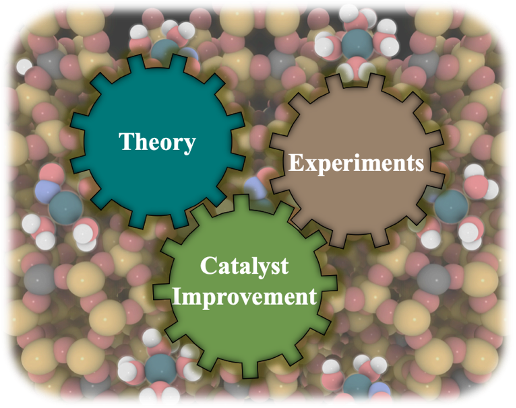(357at) Application of First-Principles Calculations and Experiments in Heterogeneous Catalysis: Emission Control and Methane Valorization
AIChE Annual Meeting
2022
2022 Annual Meeting
Meet the Candidates Poster Sessions
Meet the Industry Candidates Poster Session: Pharmaceutical Discovery, Development and Manufacturing Forum
Tuesday, November 15, 2022 - 1:00pm to 3:00pm
Passive NOx Adsorption on Pd-CHA:
Palladium exchanged zeolites have been identified as passive NOx adsorbers (PNA) to store NOx at low temperature and release it at higher temperature to a downstream reduction catalyst which converts NOx to N2.1 PNA occurs with complex exhaust feed compositions and the observed NOx uptake is a strong function of the reaction conditions and Pd loading. Notably, the presence of water leads to solvated and mobile Pd complexes that behave differently from the cationic species anchored to the zeolite framework under dry conditions.2 To this end, we have done bench-flow reactor experiments to simulate the treatment of diesel exhaust feed during warmup, with the objective of elucidating the complete reaction mechanism for NO storage and oxidation on dynamically hydrated and isolated Pd within chabazite (CHA) zeolite under realistic automotive exhaust conditions. Furthermore, we used the theoretical insights from DFT calculations alongside experiments to study the effect of CO and proposed a mechanism for CO on active site transformation and deactivation.
Our proposed mechanisms proved to be consistent with experimental observations for NOx uptake and unravel the effect of CO on active site transformation. Water, one of the major constituents of engine exhaust, was found to have a strong effect on oxidation reactions at low temperature because of the solvated nature of metal cations. Our findings showed that the presence of water causes significant changes in the binding preference of adsorbates and is mainly responsible for deactivation, which opens up an interesting avenue for catalyst performance improvement particularly to prevent deactivation.
Catalytic Properties of surfaces under dynamic conditions:
Methane Partial Oxidation to Syngas: Given the abundance of methane3, the main component of natural gas, there is a growing interest in the scientific community to utilize methane in an efficient way rather than just burning it. Even though C-H activation is feasible on PGM, the selective conversion of methane to valuable products remains a ‘Holy Grail’ for chemical engineers. Recently, dynamic catalytic operation has gained attraction to improve selectivity as well as yield for a variety of reaction chemistries.4–6 Under dynamic conditions it is possible to modify the catalyst surface by varying the reaction conditions which can result in a significant performance enhancement. Particularly, for redox reactions it is possible to feed pulses of reactants with different ratio of reactant gases and oxygen often termed as rich if oxygen is lesser than the stoichiometric amount or lean if the oxygen content is higher.
We are currently investigating supported PGM catalyst for methane conversion to syngas under dynamic conditions. To operate the reactor under dynamic conditions we are performing transient experiments oscillating between rich and lean cycles. So far, our results have shown that under certain conditions there can be enhancement in syn-gas production both in terms of yield and selectivity. Furthermore, we are investigating the changes in the surface coverages to identify the reason for the performance improvement.
Dynamics of Surfaces under External Potential: Recently the concept of “Catalytic Condenser†has been proposed where a device can manipulate the charge on a catalytic surface.7 The changes in surface charges can further affect the catalytic properties such as adsorption energy or activation barrier. Thus, through strategic periodic variation the surface charge, a catalyst can be tuned towards desired performance, in terms of selectivity, yield, turnover frequencies and more. We are using DFT calculations to understand the changes in the catalytic properties with surface charge modulation. We are actively working towards elucidating these dynamic active site modulation through exhaustive analysis of local electronic properties of surfaces.
References:
- Gupta, A., Kang, S. B. & Harold, M. P. NOx uptake and release on Pd/SSZ-13: Impact Of Feed composition and temperature. Catalysis Today (2020).
- Mandal, K. et al. Condition-Dependent Pd Speciation and NO Adsorption in Pd/Zeolites. ACS Catalysis 10, 12801–12818 (2020).
- Schwach, P., Pan, X. & Bao, X. Direct Conversion of Methane to Value-Added Chemicals over Heterogeneous Catalysts: Challenges and Prospects. Chemical Reviews 117, 8497–8520 (2017).
- Dauenhauer, P. J. et al. Catalytic resonance theory: parallel reaction pathway control. Chemical Science 11, 3501–3510 (2020).
- Karinshak, K., Chen, P. W., Liu, R.-F., Golden, S. J. & Harold, M. P. Optimizing Feed Modulation for Coupled Methane and NOx Conversion over Pd-Pt/Mn0.5Fe2.5O4/Al2O3 Monolith Catalyst. Applied Catalysis B: Environmental 120607 (2021).
- Carlsson, P.-A., Fridell, E., Skoglundh, M., Al, P. / & Al, P. /. Methane oxidation over Pt/Al 2 O 3 and Pd/Al 2 O 3 catalysts under transient conditions.
- Onn, T. M. et al. Alumina Graphene Catalytic Condenser for Programmable Solid Acids. JACS Au 2, 1123–1133 (2022).

